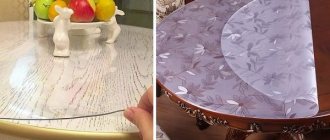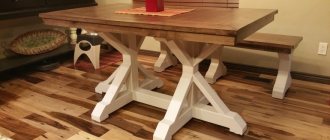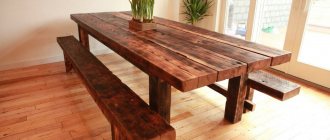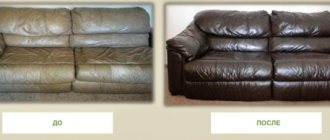Epochs change, and with them, life. Modern kitchen equipment differs significantly from the stereotypes that have developed over the years; only some accessories remain unchanged. Not a single kitchen is complete without a refrigerator, sink and stove, either now or several decades ago. One of the key parts of the work triangle is the sink. And if earlier it was, as a rule, an enameled overlay structure of white color, now the variety has increased significantly. Modern kitchen sinks are made from a variety of materials and have different shapes, sizes and design features. The owner may not always be able to install such elements. Features of different models, their advantages and disadvantages, as well as tips on how to embed a sink into a countertop - below.
Appearance of a kitchen sink, relevant several decades ago
Installation of a mortise sink
We throw the template out of the packaging and let amateurs use it. Now you will learn how experts in their field mark the tabletop.
There are a few important points you should consider:
- Overhang of the tabletop over the cabinet.
- The width of the wall plinth.
- The width of the sink cabinet.
Then we turn our basin over and place it on the countertop, taking into account the above nuances.
You should definitely invite the hostess, show her the boundaries of maneuvering and ask her to make the final choice.
Otherwise, if she doesn’t like the location of the sink, she will have to buy a new countertop. When all the wishes of the female half have been taken into account, we outline the dimensions of the sink with a pencil or a thin marker, depending on the color of the countertop.
Sink insert
- We need to insert a jigsaw into this circle; to do this, we select from our arsenal a drill with the largest possible diameter. And we make a hole, retreating inside the circle from the line, at least 16 mm. Read on and you will understand why.
- It is necessary to draw the marking line not along the jigsaw file, but along the inner edge of the jigsaw sole. The distance from the file to the edge of the inner sole of the jigsaw is equal to the distance from the edge of the sink to the sink lock. That is, this is the necessary side that the sink holds on to.
- By the way, to prevent the table top from falling on your feet, you need to tighten black self-tapping screws to any length along the cut line. Although being at three diagonal points. And then you won’t need a third hand and your legs will be intact.
Moisture protection
- Having first checked the cutout for unhindered entry of the sink and degreased it with acetone. apply silicone. Having protected your finger with a glove, carefully rub the silicone into the end, not sparing it. We make a silicone ring along the edge of the cut to prevent the penetration of moisture.
Preparing the sink
- Sink manufacturers have not yet learned how to make high-quality self-tapping screws, and I don’t think they will learn soon. If this happens at all. Therefore, difficulties constantly arise during fastening. If they are not replaced with black PH thirty.
- We carefully put on the locks. Be sure to glue the seal if the sink is not crooked. We pull in the mixer with the hoses already screwed on. We install an elbow to drain the water and only then secure the sink with locks. Do not under any circumstances overtighten the fasteners.
How to cut a circle from chipboard or a review of a circular saw with variable diameter Buttress (Ballerinka)
The stated diameter of the holes or round timbers that can be cut out using this ballerina ranges from 30 mm to 120 mm. The kit includes a key for assembling and disassembling the ballerina, as well as for adjusting the position of the cutters on the hexagon. Cone for soft materials. On the transverse hexagon there is a marking in mm, on the reverse side there is a similar marking, but there, in my opinion, it is in bourgeois units.
By the way, by default, the cutters are chamfered to meet (photo below). Naturally, I don’t understand enough about the processing of wood, but judging by an ordinary hand hacksaw, the chamfers of a ballerina’s incisors should look in one direction, and not at each other. I tried to cut out a pancake with default settings, wasn’t it enough, suddenly they invented a big one that I don’t know about yet, but somehow it didn’t work out for me. The chipboard begins to burn, the cutters warm up, but they are reluctant to climb into the chipboard. Either I pressed weakly, or it was necessary to give more revolutions. But without a machine or stand, it’s a little awkward to drill with a Chinese drill at high speeds, while supporting the boards with your feet. Therefore, I still turned one cutter on one of the holders, after that, things went much faster and easier.
In fact, the results of testing the Chinese ballerina on pieces of chipboard. Because in this ballerina everything is actually curved and is clamped like hell, I tried to set the incisors not according to the existing ruler on the hexagon, but using a caliper, measuring the distance from the drill. So that the round timber comes out without torn edges, I drill to about half the thickness of the chipboard and then unroll the sheet and cut it to meet.
READ Replacement Crankshaft Seal Stihl 180
In the photo below, for clarity, you can see the uncut penny, so the width of this groove should correspond to the width of the incisors. I don’t know about science, but I tried to do it exactly this way, maybe a little more extensively, so that the cutters specifically cut out the chipboard with the edges of cone-shaped chamfers. Since the cutters touched the planes of the chipboard and outlined two stripes on it, it is worth stopping the work and measuring the distance between these marks and, if necessary, adjusting the position of the cutters on the hexagon.
In general, if you need to cut out several holes or pancakes, then you can completely use this Chinese ballerina. But for a huge number of holes, it is still better to purchase a normal wood crown. By the way, if you have never worked with a ballerina, then I advise you to start training with ordinary crowns (a piece of pipe or tape with teeth on the edges). Because the ballerina’s instrument is somewhat specific and requires some skill and adjustment before implementation. And in uncomfortable hands, this drill turns into a rather terrible mixer for limbs, or into a centrifuge for throwing incisors at the forehead.
Write a message to the creator Creator: Nikolay Golovin – – – – – – – – 10/26/2015
Rules for installing a countertop kitchen sink
Before starting installation work, you should choose the place where the structure will be built. Usually it is tied to sewerage and water supply. It is possible to embed the device anywhere in the headset. When choosing an installation location, it is advisable to follow these recommendations:
- The bowl is placed as close to the work area as possible, making it more convenient to cook.
- The design divides the work surface into two parts: dirty and clean. In the first, food is processed, in the second, they are served.
- It should not be installed near a stove or refrigerator. It's not practical.
- It is advisable that there be light where the bowl will stand. If necessary, additional lighting is provided.
- For a functional kitchen, it is best to choose a deep appliance: you can wash large dishes and other large items in it. A low mixer will give a minimum of splashes during operation.
How to cut a hole for a sink in a countertop?
The furniture manufacturing industry provides an unlimited number of different kitchen furniture to choose from. From time to time, the dishwasher is offered separately, and is installed by the buyer independently. This does not require any special knowledge or abilities.
If the sink is purchased separately and will need to be installed, it is better to entrust this work to experts.
In order to make a hole correctly, you need the most common tool. The question of how to cut a countertop for a sink is not very difficult. But if you do not follow certain installation requirements, the installed equipment can be damaged.
READ Motor for Circular 220V Which one to choose
The sequence and manipulations performed are similar to cutting a hole in chipboard.
In order to make a hole correctly, you need the most common tool.
The location for the cutout is selected taking into account the short distance for draining water into the drainage ditch and connecting the water supply.
It is better to do this outdoors, because there will be a lot of dust during the sawing process.
The sink can be installed relative to the level of the working surface using the following methods.
- Below the table top. This placement looks very nice, but will additionally require the implementation of a special tool. The sink itself must have a certain shape. In this case, it is attached from below using special fasteners. They are usually sold as a set. The open end must be impregnated with a water-repellent agent. However, it must be of sufficient thickness.
- At the same level. In this situation, it is very important to correctly make the necessary recess equal to the thickness of the side. It must be flawless around the entire perimeter of the installed sink.
- Above tabletop level. For this type of installation you need the most common tool. No special effort is required for this installation.
You will need to wear protective gloves on your hands, and protect your face with a special transparent mask.
From time to time, the dishwasher is offered separately, and is installed by the buyer independently.
What to prepare before installation
For high-quality insertion of equipment into the countertop, in addition to the plumbing fixtures, you need to prepare:
- electric drill and jigsaw;
- Screwdriver Set;
- drill bits;
- pliers;
- square, pencil and ruler;
- fasteners, if they are not included with the device;
- rubber seal;
- silicone sealant.
Need to inspect carefully before purchasing. It should not have any dents or scratches if it is made of stainless steel. If not, you need to additionally check for chips. Even small defects will not allow it to fit tightly to the base, and this is unacceptable.
It is optimal that the kit includes good quality fasteners. Otherwise, it is better to purchase them.
Equipment and tools for sink installation
To cut a hole in the countertop for a sink, no special abilities or experience are required. But tools and equipment must be available.
- ruler;
- pencil;
- corner;
- level;
- tape measure;
- screwdrivers;
- rasp;
- screwdriver;
- adjustable wrenches;
- a set of wrenches;
- brush;
- a drill for woodworking with a diameter of 10 mm;
- electric jigsaw;
- electric drill;
- PVA glue;
- suitable sealant.
Tools must be of high quality so as not to spoil the whole process.
Performing markup
Installation is a labor-intensive process that requires special care, as well as certain skills, because even the slightest mistake can ruin both the product itself and the countertop. Therefore, one of the most important stages in the installation work is marking.
There are standard placement rules that should be followed when marking:
- It should be located at least 5 cm (50 mm) from the edge of the tabletop on the front side.
- From the rear end, the distance from the edge of the cut should be no less than 2.5 cm (25 mm), since there is less pressure on the structure from the rear side.
- Do not place it near a gas stove, as splashes of water may extinguish the fire. Designers recommend placing it in the middle between work areas, this will ensure comfortable work. The kit includes a special template printed on the packaging. It needs to be cut out, attached to the tabletop and secured with masking tape, then outlined with a pencil. If there is no template, then the product must be turned over, laid on the tabletop and traced.
- After drawing the first line, you need to make an indent of 2 mm inward from it and draw a second line - the cutting line. This distance must be strictly adhered to, since if you make it smaller, it will not fit, and if it is larger, then problems with fastening and sealing may arise.
- Also, when determining the location for placing the sink on the countertop and marking, it is necessary to take into account the placement of the input and output of plumbing pipes; they must freely approach the central point
How to cut a hole in a countertop for a hob
The first step is to determine the outline of the slab. Almost always it should contain an annotation on how to do this, but there is a technique that only indicates the recommended hole sizes. Place the hob on the countertop, which is placed on top of the slates. Leave the recommended distance from the back panel to the front edge of the tabletop.
Draw a median on the tabletop and mark the cut-in mowing line using the manufacturer's annotations.
Marking the countertop for the hole for the stove
As you can draw in the picture, you will need an L-shaped square, a tape measure and a carpenter's pencil to do the job properly. Make sure that the cutting line cuts are parallel and placed at right angles. In addition, the rectangle must be symmetrical.
Tip: Check that the rectangle under the kitchen cabinet in which the hood will be built is correctly placed and there is enough space around it (in accordance with the manufacturer's instructions).
Installing spacers under the countertop
To get a clear result, you should place several spacers under the tabletop. But the tabletop must be level.
You should leave about 5 cm of free space between the cabinets and the countertop, otherwise the saw blade may destroy them.
Making initial holes for drilling
Use a drill with a special bit to create initial holes along the corners. It is very important to align the bits correctly, otherwise you will be able to drill outside the contour.
Tip: Make sure you are using good speed controlled drilling equipment. Set the drill at low speeds and hold the drill with both hands if you want to have good control over it. Repeat the process for each corner of the rectangle.
Passing the laminated layer
In this image you should see the drill bit going through the top layer. Do not use too much pressure on the drilling equipment, otherwise it may slip out of place.
We remove residues from the process with a vacuum cleaner
Drilling a hole in the countertop with a drill will create a lot of residue, so we recommend that you have someone clean it up as you make the hole.
Tip: Work with great care and attention, because it is important to make the holes exactly in the marked places.
Initial holes for cutting in the tabletop
After drilling the corner pilot holes, you need to make cuts along the guide lines. If you are not experienced in this area, you should cover the cut line with masking tape. In this way, you will help prevent the edges from fraying.
Cutting a hole in a tabletop with a jigsaw
To make the cuts, we recommend that you use a jigsaw. Choose a blade with the teeth pointing down. In addition, the blade must have set teeth. If you have not worked with a jigsaw before, we recommend securing the tabletop for you. Make sure the blade runs exactly along the cutting lines.
Tip: Remove the shavings that often appear, otherwise they may cover the mowing line. Set the jigsaw at low speeds.
Finished hole in the countertop for the stove
And last, but more important: you need to take care of installing the hob into the countertop with your own hands. If you followed our advice and read the manufacturer's instructions, the hob should simply fit into the hole. But, if the edges are not completely straight, you can smooth them with silicone or sealant.
Tip: Use sandpaper to smooth the cutting edges.
Installing the hob into the countertop
After that, all you have to do is install the hob into the countertop, connect it and secure it with the screws that should come with it.
Thank you for reading our step-by-step recommendation on how to cut a hole in a countertop and install a hob with your own hands, we advise you to read other articles. Don't forget to share our projects with your friends using social network widgets.
Cutting the countertop to fit the size of the sink
- You need to cut out a place for it in the countertop. On the marking lines, drill a hole of at least 10 mm using a screwdriver in order to insert a jigsaw file into it. And with the help of a jigsaw, carefully, without jerking and strictly along the intended line, make a cutting.
- We check the correctness of the cutting; to do this, you need to insert the shell into the cut hole. If it fits in easily and there is a small gap between it and the countertop, everything is done correctly; if the sink fits in tightly, then additional trimming needs to be done.
- The next stage is processing the cut line, for this you need to rub it with fine-grained sandpaper, clean it of dust and shavings and treat the surface with a degreaser, and then with a sealant.
If the countertop is made of moisture-resistant board, it is not necessary to use sealant.
- If the structure is rectangular, then cutting a hole for it is very simple, but with a round or irregularly shaped sink, this is more difficult to do, you need to be especially careful and careful
Features of working with artificial stone
As a rule, stone countertops are made to order in accordance with the preferences of the buyer, and the hole for installing a sink is provided in advance. But there are also exceptional cases when, for example, it was initially planned to install an overhead sink in the kitchen, and the countertop had to be solid.
An artificial stone countertop is quite difficult to process. It must be handled with care as the material is fragile
For such work, it is better to invite a qualified specialist with a professional tool, who will make a hole of the required diameter with a correctly processed cut and install the sink in accordance with all requirements.
If you decide to make a hole for installing a sink on your own, saving on labor costs, instead of a jigsaw, it is better to take a grinder and when cutting, protect your eyes and respiratory tract from stone dust. The work algorithm is not much different from installing a sink in an MDF countertop.
Note. To work with artificial stone, you need to install a concrete disc with laser chips on the grinder.
Fixation methods
Depending on the material, it can be fixed with glue or fastening materials, but it is better to use these means together.
Glue is more suitable for fastening stainless steel products; this method will allow you to securely fasten the sink to the countertop, but only with the correct fit. Before the gluing process, you need to prepare the surfaces and apply a special polyethylene sealant. We coat the places of future fastening with glue, press it well, it can be used only after 24 hours.
Fastening materials are a more reliable method of fastening, but it must be combined with glue to prevent water from entering at the screw fastening points.
It is better to fix the fasteners using a screwdriver rather than a screwdriver, so as not to damage the product. You need to tighten the screws one by one, checking the fit.
How to cut a large round hole in chipboard, plywood
Using improvised means
For shaped parts, it is better to have special devices, but making a round hole in a slab of glued veneer can be useful to any craftsman. Below we will tell you how to cut a circle from plywood when you have nothing at hand. Well, practically nothing:
- For cutting plywood, a wooden strip with 2 nails is used.
- One nail is driven through the strip into the workpiece, exactly in the center of the hole being made.
- We drive the second nail into the bar in such a way that the tip protrudes on the wrong side by at least 5-10 mm. The distance from the first nail should be equal to the radius of the hole being made.
- Rotating the bar, use the tip to draw a groove on the plywood, deepening it with each turn.
- Instead of a stick, you can use a strong cord. The working mechanism remains constant.
Scheme of “threading” with the introduction of nails. The sharper the nail used, the faster the hole will be made. It must be emphasized that although the cost of such a device is small, it is worth using only when other methods are unattainable: the edges still turn out to be far from the standard.
Rules for connecting to communications
After completing the work of attaching the sink to the countertop, you can begin connecting it to the communications.
- Securing the cold and hot water supply hoses - on one side to the mixer, on the other - to the water tap. When connecting, we use rubber gaskets to seal the joints.
- Release the siphon and discharge it into the sewer pipe.
- Check all connections for leaks and install additional seals if necessary.
- If the diameters of the siphon and sewer pipes differ in size, then a special sealing cuff-adapter can be used to securely fasten them
Installation of sink and connection of communications
A drain is installed to the bowl and, if provided for by the design, a mixer (water tap). All gaskets are installed in the appropriate sequence. Typically, the layout of the gaskets is indicated by the manufacturer on the packaging of the mixer and drain siphon. Threaded connections can be easily tightened with wrenches or, if necessary, with an adjustable wrench.
When purchasing kitchen furniture with such a surface, it is better to have a ready-made product that will only require connections to the water supply and sewerage system.
If the structure on which installation is planned does not have holes for water supply and drainage, they should be cut out. They are done in the same way as for washing. It is drilled with a drill and a suitable clearance is cut out with an electric jigsaw. You can use a drill with a special drill - a furniture crown, just immediately take such a drill of the required diameter.
For this, the sink is used as a template.
The sink is covered with a sealing tape supplied with the product. A small gap is left from the edge, which is then filled with sealant. Fastenings are being installed.
Some manufacturers and manufacturers of sinks include a template with the product itself.
Reapply the sealant to the contact points and let it dry a little, 2-3 minutes. Place the product in place and tighten the fasteners. Secure the tabletop together with it in its own place and connect the water hoses. Connect the drain. Go over the joints again with sealant; excess must be removed.
Before cutting a hole in the countertop for the sink, mark the required hole.
Professional advice on installing sinks: what to look for
Experienced installers share the following secrets of their work:
- When installing a mortise sink yourself, you need to check the dimensions of the hole several times. It should not be too large, otherwise it will “walk” in the groove, and the fastenings will not provide the required strength.
- When installing a stainless steel sink, do not over-tighten the screws. This may cause damage.
- Instead of the seals that come with the kit, you can use sealant. You shouldn't save it. It’s easier to carefully remove excess than to deal with leaks later.
- When using a screwdriver or a screwdriver, it is important to be careful not to bend the hardware.
Installation features
We install a corner sink.
Sawing a right angle. In order for an electric jigsaw to easily pass through the corners of the tabletop, several holes are first made in them with a drill, one after another, and they are combined.
You should also pay attention to the fact that the corners and connecting lines of the inner and outer corners of the cabinet coincide.
We cut in a square sink.
Installing a sink into a countertop begins with drawing a line that runs parallel to the edge of the countertop. Then make an indent to the width of the sink and draw a second line. In a similar way, two perpendiculars are measured and laid. Mark the intersection point of the segments that connect opposite angles. The siphon is located in this place.
Installing a stone sink
Sinks made from natural stone, such as granite, do not have faucet or drain holes. The first can be mounted separately to a tabletop or adjacent wall. And it is impossible to do without a siphon.
Carefully making such a hole in a natural stone sink yourself, without sufficient knowledge and experience, is a very difficult task. For this you need an electric drill with diamond bits. For this reason, it is better not to install granite products yourself, but to trust specialists.
Necessary materials
The sealant is used to prevent water from entering the contact points between the sink and the countertop. Water can greatly damage chipboard. Each surface has its own sealant. When working with artificial stone, only silicone is used. Sealants containing alcohol are often used on wood and plastic.
If you decide to cut a hole in the countertop for the sink yourself, you will need a special tool - a grinder with a diamond wheel.
The application of sealant not only prevents unnecessary water penetration. This also serves as additional strength to the connection.
If the sink is purchased separately and will need to be installed, it is better to entrust this work to experts.
- electric drill
- electric jigsaw
- wood drill with a diameter of 10 mm.
- set of wrenches
- brush
- adjustable wrench
- rasp
- screwdriver
When purchasing kitchen furniture with such a surface, it is better to have a ready-made product that will only require connections to the water supply and sewerage system.
Before cutting a hole in the countertop for the sink, mark the required hole. To do this, a template is made from cardboard or thick paper. Some manufacturers and manufacturers of sinks include a template with the product itself. If you have chosen the option of installing on a table top and the sides are of sufficient width, you can mark without a template. For this, the sink is used as a template. The upper surface is applied to the plane and traced along the contour with a marker or pencil. For ease of installation, it is better to remove the tabletop. Having retreated 0.5 - 1 cm inward from the drawn line, a working contour is drawn along which the cut is made.
It will look more solid, but it will be more difficult to install a sink in it without the help of others.
Having marked the cutting line, the template is removed and you can begin the process of cutting out the place for washing. A drill is used to drill a place for an electric jigsaw file, approximately 10 mm in diameter. For a quadrangular or triangular sink, holes are made in all corners. If the product has a round or circular shape, 1 will be enough for the job.
It’s easy to install a sink in a countertop made of wood or chipboard if you have the required tools and simple handling skills.
The hole and cut are made from the side of the laminate, this will prevent it from chipping. Use a jigsaw to carefully cut out the required hole along the drawn contour. The electric jigsaw must be pressed firmly against the surface. The saw blade should go exactly at a right angle.
The sink is covered with a sealing tape supplied with the product.
The inner part being cut must be supported while doing this work. Or position the tabletop so that when cutting is completed, this part does not fall off. If the remaining and removable parts are abruptly separated, the laminated coating may crack. Or a part will break off from the chipboard.
You can use a drill with a special drill - a furniture crown, just immediately take such a drill of the required diameter.
If there is no room for such an arrangement, or the tabletop has not been removed, use construction tape. Sawing is done in this case with stops. A 10-15 cm cut is made, which is then taped on both sides.
A drain is installed to the bowl and, if provided for by the design, a mixer (water tap).
After the cutting is completed, the sink is first tried on. It should fit freely, and the gap should not be huge. If it fits very tightly, you should widen the installation site with a rasp or jigsaw.
Having marked the cutting line, the template is removed and you can begin the process of cutting out the place for washing.
Now you should painstakingly “sand” the inner end to which the sink will adjoin. This is done with fine grit sandpaper. The resulting dust is removed, and a thin layer of sealant is applied to the contact area using a brush.
For ease of installation, it is better to remove the tabletop.
Selecting a sealant
The sealant plays an important role in installation. The building materials market offers several options for this product:
- acrylic - does not contain harmful substances, is excellent for metal, chipboard and MDF, dries quickly. The main disadvantage is strong shrinkage and rigidity; joints can crack over the years and will allow water to pass through;
- polyurethane - suitable for places with high humidity and unstable temperatures, good adhesion to almost all materials. The sealant is elastic and practically does not shrink, but it is better not to use it for MDF, chipboard, or plastic. The polyurethane composition is ideal for products made of stone, granite, metal;
- silicone - elastic, does not shrink, good adhesion.
Apply any sealant to clean materials to improve adhesion. Without preliminary preparation, cracks may appear and moisture may enter.
HOW TO CORRECTLY MARK A DRINK UNDER THE WASH
On the Internet, this point is written minimalistically and smeared, something like this: “Mark correctly and cut out with a jigsaw.” Let's look at how to properly mark the drinks under the sink.
For example, you bought a round sink and you need to cut it into the cabinet at 800 mm. If a template is included with the sink, then everything is simple, but if it is not there, then we do the following.
STAGE 1. Looking for a location
The first task is to decide where it is best to place the sink. Let me explain - in our example, the sink is round 51 (or 49) cm in diameter, and the cabinet itself is 80 cm, therefore, it can be moved to the left or right, or embedded in the center.
When marking the sink, pay special attention to the corner version (90 gr. version) of the kitchen, since the convenience of approaching the sink depends on your choice.
STAGE 2. How much to retreat from the wall?
Having decided on the location, place the sink on the countertop with the bottom facing up. Now you need to decide how much you need to retreat from the wall. This point is especially important if your sink is 51 cm deep. If such a sink is placed exactly in the middle of the countertop, then there is a high probability that your saw will pass along the front plank of the cabinet (this depends on the design of the cabinet itself). The easiest way is to place a kitchen plinth against the wall and move 1-2 cm away from it. This place will be the outer edge of the sink.
If the cut line still goes along the body of the cabinet, then you need to either pull off the bar of the cabinet, or remove the tabletop from the body, cut it out and put it back in place.
STEP 3. Draw a cutting line
Now we need to decide on the line of the cut itself.
To do this, you need to measure the distance from the outer edge of the sink to the fasteners (fastening ears). Usually this size is 1-3 cm, but it may vary for different sinks.
We already have a drawn line of the outer contour of the sink. Now we measure the just measured distance from it into the future sink and draw the internal contour. This is the cutting line.
Stage 4. Ewing
Using a drill, from inside the contour, next to the cut line, we make a through hole. We do it so that the jigsaw blade can pass through.
Use a jigsaw to cut along the contour of the cut. When cutting, do not rush and do not press too hard with a jigsaw.
It is better to cut with a “Clean Cut” blade. If the sink is rectangular, then to prevent chipping, you can use masking tape. When choosing a file, consider the cutting height.
Stage 5. Preparing the cut
- After cutting, you need to process the edges of the cut.
- We level the cut with coarse sandpaper and try on the sink with fasteners.
- If everything is fine, then we clean the saw cut from dust and coat it with silicone.
- Silicone will subsequently prevent the tabletop from absorbing moisture and swelling.
Stage 6. Attaching the sink
Usually the sink is attached to the countertop with the faucet already installed, since doing this under the sink is extremely inconvenient.
The new sink is equipped with a sealing tape, which we glue along the edge of the sink into a special groove. For greater reliability, you can apply silicone along the edge.
We insert the fasteners into the ears of the sink, with the hooks to the countertop, bend them inward and insert the sink into the cut hole.
We move the structure a little so that the sink sits correctly and tightly. We hook the sink to the countertop with fasteners as shown in the figure and use a screwdriver to pull the sink to the countertop. Don't over tighten the washer.
You should not use a screwdriver to tighten the sink, as it is very easy to unscrew the fastening thread.
You can feel the tightening force with your hand, but some fasteners are very weak in tightening.
Why mortise: reasons for choice
The aesthetic component of a kitchen sink is far from the only criterion for choosing a mortise design. Why do modern consumers love this type of sink so much?
A built-in sink can have either a standard siphon or an expanded hole, which is initially provided for installing a disposer
Design advantages:
- Possibility of installation anywhere. By purchasing a mortise-type product, you do not depend on the cabinet installed under it. The bowl can be embedded in any place, the main thing is to provide communications.
- Lack of moisture. When using an overhead structure, it is impossible to hermetically seal the joints between the modules, the washing block and the walls. Almost always, water flows into the resulting cracks, which is fraught with rapid destruction of furniture and dampness on the walls.
- The choice of mortise sinks is much wider than in the case of overhead sinks. They can have different shapes, functionality, number of bowls, materials of manufacture and sets of additional accessories.
- Modern appearance combined with affordability. The mortise accessory looks almost like an integrated one, but costs much less.
A built-in sink may include removable cutting boards, grids for washing food and other accessories.
LITTLE TIPS FOR THOSE WHO INSTALL A DROP-IN WASHER THEMSELVES
If you have more drink under the sink than you need (but not more than the sink itself), then it is easier to secure it with fastenings if you attach plywood inserts from the inside, at the fastening points. We align some edges of the inserts to the sink at the required distance, and screw the others to the countertop.
- Sometimes sink fasteners work well to attach the structure to a thick countertop, but do not attract it to a thin one. Using the same inserts, you can artificially increase the tabletop at the fastening points.
- If all the fastening lugs on your sink have broken off, you can simply glue it with silicone, placing a weight on it while gluing.
- If you have a sink, but do not have fastenings, then you can buy a kit for fastening the sink in the store. Usually it consists of the fasteners themselves and the sealing tape.
- It happens that you pull the sink, and the fastenings either move off the edges of the cut or become unbent. In this case, you can screw the fastener to the tabletop with a self-tapping screw and then the fastener will not move out.
How to properly install a sink in a countertop: a simple algorithm
In this article, we will look at one very severe operation, which very much has an impact on the quality of the kitchen set.
We will talk about installing a sink. We will look at this entire process from start to finish with all its aspects.
Before installing a sink, you need to decide in which part of the countertop it should be placed.
To do this, the countertop must be placed on the lower modules of the kitchen, and the box in which the sink should be located must be traced from the inside with a pencil (along the countertop) to find an internal place for it.
After that, the table must be placed with the bottom up, and the place for cutting the hole must be marked. This is done as follows:
First, the position of the sink itself is determined (it should not go beyond the inner border of the box; otherwise, to insert it, it will be necessary to cut not only the tabletop, but also the sides of the box
- When the position is determined, it is outlined with a pencil along its own contour
- Then, using a tape measure, you need to measure the distance from the edge to the eyelet into which the fastener is attached
- After which, if the sink is round, the center of the drawn circle is located. It is located in the following way: on the circle, in any place, a point is placed to which a straight piece or ruler is adjusted. To this straight line you need to attach another part (or a square) with a right angle. A fishing line is drawn in the area of the center. Then the 2nd point is taken and the same thing is done. The place where two straight lines intersect will be the center of the drawn circle (yes, from time to time knowledge of geometry may be very necessary)
- A mowing line (such as diameters) is drawn through the center of the circle. They are necessary in order to use them, from the edge of the circle, to measure the distance we measured from the edge of the sink to its eyelet for the fastener.
- Having made 8-10 such “notches”, through them, using the same sink, we draw curves (in parts), which form inside the circle we drew, another circle , the radius of which is less than the radius of the main circle at a distance from the edge of the sink to its ear. This will be the circle that needs to be cut out with a jigsaw.
- We make a hole on the inside of this circle with a large drill (usually a drill with a diameter of 10 mm).
- We insert a jigsaw file into this drill and cut out a hole. Don't forget to support the cut part of the table top when the hole is almost cut out, because it can break off, breaking the plastic from the front part.
When the hole is made, its inside must be sealed with silicone, because this place is the most problematic place in the kitchen. It must be very protected from water getting inside the countertop, because in this case, the countertop can simply be “torn” by water - and this is a complete replacement.
So, after the hole is “siliconized”, we begin to prepare the sink for insertion.
To do this, you need to glue adhesive tape to its inner surface, which is always included in the kit (plus fasteners and, plus, plastic tubes for draining).
Please note before you pick up the sink: The adhesive tape (which needs to be glued inside) should not be stuck on it. It should come included. At almost all sinks where adhesive tape was previously applied, it was applied incorrectly.
Surely it is glued so that there is a small distance between it and the side of the sink itself (there seems to be a gutter there) where the silicone is poured.
It turns out that there are two barriers at once: adhesive tape and silicone.
So, when all this is done and the silicone is poured, the sink is inserted into the hole cut in the countertop (from bottom to top). If the tabletop is placed, for example, on two chairs, then one of them can be immediately placed under the sink, thus fixing it.
I would like to note that this is one of the most annoying moments when installing a kitchen set.
The fasteners with which it is attached to the tabletop are usually not good (meaning poorly thought out). Problems almost always arise with it (for this, it is necessary to always have spare versions of this fastener for installation).
There are situations when it simply does not fix the countertop, but slides off to the sink (which is what happened during the installation, photos from which are posted in this article as an example).
No matter how much we bent the tendrils of the fastener itself, it stubbornly jumped off the tabletop (and, obviously, did not fix it).
The most common way out of this situation is as shown in the pictures: you need to stick a piece of chipboard or something else between the sink and the fastener itself. In this way, the fastener is fixed and, twisting, attracts the sink.
But we must not forget one detail: it is necessary to practice installation, but not for very long, because the silicone that was poured into the sink, when it was pressed to the countertop, partially “came out” out. It should not have time to harden, because in this case, when removing it, you can also remove part of the silicone located under the sink.
When it is pulled to the tabletop, you need to make sure that there are no gaps between it and the tabletop. If they are, it means she is poorly attracted.
At the end of the insertion, it is necessary to wipe off the silicone that has protruded from under the sink and the sink itself.
This is where I end, see you in new articles.
Sources:
https://womanadvice.ru/kak-vrezat-moyku-v-stoleshnicu https://interiorfor.com/ru/remont-kuhni/oTVerstie-v-stoleshnitse-pod-varochnuyu-panel/ https://sity-mebel .ru/dsp/kak-vyrezat-krugloe-oTVerstie-v-dsp.html https://berkem.ru/kuxnya/kak-vyrezat-oTVerstie-pod-mojku-v-stoleshnice/ https://www.sdmeb. ru/kuxni/kak-ustanovit-mojku-v-stoleshnicu.html
Features of sinks
It is important to select plumbing fixtures according to the volume and depth of the bowl. It is convenient to use a deep sink. Mount the mixer at a moderate height. Otherwise, splashes of water while washing dishes will wet your outerwear and kitchenware.
The kitchen design should be thoughtful and ergonomic. The distance from the sink to the refrigerator or stove should be 40 cm. The same requirements apply to the hob. For right-handed people, it is better to install the sink at home on the right side, and the dryer on the left.
The sink should be located in close proximity to drains and water pipes.
When choosing a sink to install on your countertop yourself, it is important to consider the following features:
- Capacity of the structure. The size and quality of the dishes in the house that the housewife will use depends on this.
- Product functionality. You can put a round sink at home on a couple of bowls. Equip everything with dryers, wings and other accessories. These elements will simplify the workflow of cooking and cleaning dishes.
- Ease of use. Depends on individual characteristics. The choice is made by the owners of the premises themselves.
- Wear resistance of the shell material.
- Combination of sink with kitchen style.
- Product form. There are figured, rectangular, round, oval designs. The universal shape is easier to care for. Complex creative options will decorate the interior of the room, but will not become practical plumbing fixtures in the house.
- Availability of additional options , such as installing a faucet for purified water (filter), a connector for connecting a garden hose.
In order to qualitatively cut a sink along the contour with your own hands, you need to know possible errors and installation instructions, the stages of performing the work for different types of installation.
ADVICE. You should not cut out a sink in the countertop yourself at home if you do not have experience in this matter. It’s better to take a simpler option, which is easy to install using a video from the network.
Shell materials
- The most popular options are stainless steel sinks. They are functional, inexpensive, and easy to clean. The products are suitable for any interior. You can check steel for quality using a regular magnet.
It is simply applied to the metal. If it does not fall off and holds well, then the product is made of good steel. When the magnet falls off when you touch it a little, then it’s better not to take such plumbing equipment home.
Sinks made of steel and granite can be mortise or overhead. Installing such sinks into a kitchen countertop yourself is not a difficult process. You should take care of the base in advance. The enameled version is also in demand. It is difficult to work with ceramics as they are easily scratched.
ADVICE. Due to its heavy weight, a ceramic sink can be easily dropped and may injure a person. A beginner is unlikely to be able to cope with inserting a sink into a countertop without outside help. Keep in mind that such sinks usually do not have great depth.
The advantages of mortise-type sinks include:
- Easy to clean.
- Hygiene.
- Variety of shapes. There are options with a large working surface.
- The presence of a small side up to 5 mm.
- Large range of products and mixers for installation.
Follow our tips on how to properly install a sink in your kitchen yourself. This will ensure a tight junction of the product with the table and will prevent moisture from forming in the area between the cabinets and walls.
Types of kitchen sinks by shape
The shape of the kitchen sink depends on the number of bowls, type and installation location.
Kitchen units are:
- square;
- rectangular;
- round;
- triangular;
- complex shape.
A kitchen sink of complex shape is made exclusively to order and usually has an under-counter or integrated installation type.
Kitchen sink designs can have not only different shapes, but also the number of bowls. Standard models are usually equipped with one or two bowls, while atypical models can have up to four.
An example of a round sink with four bowls, a fruit rack and a cutting board
Video - DIY sink and faucet installation
We select tools and materials for work
To fasten the sink quickly, you need special tools. Be sure to check before cutting along the marked edges of the countertop for a home sink that the kit includes fasteners for it.
ADVICE. Manufacturers usually add double-sided clips to the box. The elements must be secured to the ends of the already cut table and to the inside of the sink. Additionally, there will be a tubular seal to seal the joints.
Take care of these tools:
- Jigsaw, set of blades for it. You can take a regular saw.
- Drill and drill bits of different diameters.
- Measuring devices - water level, tape measure, knife, ruler, screwdriver, square.
- Silicone sealant.
- Plumbing fixtures are installed on cabinets with sliding, opening doors. The back wall remains open in them. This allows the plumbing and drainage to be collected correctly. It is easy to access the pipes at any time.
- Before cutting out the countertop for the sink at home, you need to have rubber gaskets on hand. They will have to be used when installing the sink to remove water leaks. Parts must be treated with waterproof products.
A durable cabinet is the key to durability
Overhead and mortise sinks are installed in cabinets with opening or sliding doors. In this case, the back wall of such a cabinet should be open. In order to assemble the cabinet correctly and reliably, you need to know several mounting features.
The bottom line is that such structures do not provide additional reinforcement and bulkheads, as this may interfere with the sewer pipes and the installation of the sink itself. In this regard, the cabinet does not have additional stiffening ribs, which will affect its service life. Moreover, if you install a countertop sink, it will not even have a countertop. Instead, the entire top of the cabinet will be occupied by a steel sink panel. This will also negatively affect the strength of the structure.
A special feature of assembling a sink cabinet is a careful approach to its strengthening. It should be much stronger than other kitchen furniture. When installing a sink in the kitchen, you need to place rubber gaskets under the cabinet. This will prevent water leakage. Even with great tightness, moisture can penetrate under it. It is advisable to treat rubber gaskets with waterproof agents. In the inside of the bedside table you need to install fastenings for jumpers. They are installed after installing the sink and connecting it. Such jumpers can be made from thick planks.
Under-desk models
The peculiarity of such sinks is that they are installed at the same level or slightly below the level of the countertop itself.
It will be difficult to cope with such a task yourself, since the process is labor-intensive and requires considerable experience. In fact, here you will have to remove the bead layer. This option is relevant for sinks made of artificial stone, natural material, and steel. Sometimes you can’t do without a diamond-coated saw.
In this situation, it is indeed wise to seek professional help.
By the way, try not to screw in the screws of power tools, since too much force can damage both the sink and the countertop itself. I also strongly recommend replacing the rubber seals, which often come with sinks, with a high-quality sealant. The seal cannot provide a good fit, plus its service life is several times shorter compared to sealant.
Types of sinks by material of manufacture
If previously washing accessories for the kitchen were traditionally made only of iron, cast iron or stainless steel, then the modern choice of materials is much wider.
Artificial stone sinks are the second most popular after stainless steel sinks
So, today on the market you can find shells from:
- natural and artificial stone;
- ceramics;
- natural wood;
- earthenware;
- of stainless steel;
- enameled metal;
- glass
Kitchen sink made of earthenware or ceramics. Photo source – https://obzor-expert.com/kak-vybrat-mojku-dlya-kuhni-rejting-top-10-luchshih-modelej/
The easiest to install are stainless steel sinks. Glass sinks are difficult to maintain, while earthenware sinks are finicky to use. Sinks made of artificial stone require regular cleaning, but few people can afford granite ones.
Tricks of professional installation
The main difficulties in installation arise when making the hole: if the gap between the edge of the table top and the bowl is too large, the legs of the fasteners may bend. If your hand is not steady, it is better not to touch the marking line when cutting, but if necessary, adjust the size with a rasp.
When the sink is pressed, the silicone should not burst. It is better to squeeze out a small drop from the tube in advance and observe how long it takes for a sufficiently strong film to form on the surface.
The fastening screws should not be tightened too much, especially with increased clearance. This leads to the fact that the sides of the sink do not press down, but bend upward. A small gap between the side and the countertop can also be sealed with silicone.
Kitchen countertop materials
To make the right choice, you need to have information about what countertops are created for the kitchen. There are plenty of options to suit every taste and budget. There are simply multifunctional ones, and there are also those that become a decoration for the kitchen. The main aspects of choice are:
- aesthetic and appearance;
- waterproof and moisture resistant;
- resistance to mechanical damage;
- compliance with hygiene requirements;
- environmental friendliness;
- coating durability;
- resistance to external causes.
The main and most common materials for the production of countertops are:
Design types of kitchen sinks: brief description
There are a number of requirements for installing a kitchen sink, and therefore it must be carried out in accordance with a certain technology. The choice of the required technological solution, and, accordingly, the installation method depends on the design of the sink. Let's look at the most popular design types:
Overhead sinks are the most budget-friendly option, the distinctive feature of which is the ease of installation of the structure.
The principle of their installation is based on the fact that the sink is placed on a separate cabinet, and therefore they become a continuation of the countertop, as if replacing it. Despite the undeniable advantage described above, sinks of this type also have disadvantages - the relatively small thickness of the product and the formation of a gap between the sink and the countertop, which leads to additional inconvenience;
Important! Experts recommend giving preference to overhead models if the kitchen set consists of separate sections. If kitchen modules are combined under a common countertop, it would be more appropriate to use built-in models.
Built-in sinks are models that are installed directly into the countertop; therefore, installation activities must begin with the preparation of the appropriate hole in the countertop. The technology for installing mortise sinks involves attaching the structure to the inside of the countertop using special clamps and brackets. Built-in sinks of this type are characterized by a solid appearance and ease of use.
Despite the fact that the cost of such models is somewhat higher, experienced specialists often prefer them due to their practicality and the ability to avoid moisture accumulation between the cabinets;
Undercounter sinks are innovative models, the high cost of which reduces their widespread availability and limits their widespread use. The principle of installation of these plumbing products involves their fastening below the level of the countertop, and therefore they form a single whole with it.
The advantages of undermount sinks are their aesthetic appearance, high noise absorption and effective sealing of joints. In addition, such products are hygienic and durable.
Installation methods depending on the type of sink
The type of sink determines how it is installed on the countertop. Most often found in the kitchen:
- overhead - cheap and cheerful, but gaps still remain, installation is carried out on a separate module;
- mortise - reliable, but more expensive, fastening goes through clamps and brackets into a base cut specially for the sink.
There are also under-table options. But they are used quite rarely: they are expensive and not always suitable. Here you also need to cut a hole, but it is located slightly below the level, creating the illusion of integrity with the tabletop.
See also: Installing a dishwasher in a finished kitchen: 6 installation steps + video instructions











